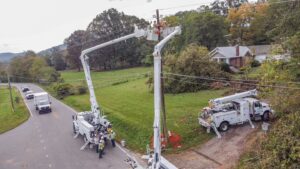RALEIGH, N.C. — Participants in the Carolinas Transmission Planning Collaborative (CTPC) have identified 121 major transmission projects as part of the 2024-2034 Collaborative Transmission Plan (“2024 Plan”) that will improve electric transmission infrastructure. The projects represent $2.956 billion in new transmission investments during the next decade. This includes 99 reliability projects representing $2.076 billion in investments and 22 approved public policy projects representing around $880 million in investments.
The projects identified in the 2024 Plan are expected to enhance system reliability and resiliency by replacing aging infrastructure, supporting the addition of new generation resources, and potentially enabling increased economic electricity transfers across the transmission network.
The 2024 Plan report can be viewed on the CTPC website under the “References” section at https://carolinastpc.org/.
The 2024 Plan, relative to the 2023 Plan, includes 37 new Duke Energy Carolinas (DEC) and 15 new Duke Energy Progress (DEP) reliability projects totaling $365 million in new transmission investments. Appendices C and D in the 2024 Plan report contain the specific details on all 99 reliability projects identified in the 2024 Plan, which includes 47 remaining reliability projects from the 2023 Plan report. The in-service dates and cost estimates for some planned or underway 2024 reliability projects have been revised from the previous year’s plan report.
The 2024 Plan, relative to the 2023 Plan, includes four new DEC and three new DEP public policy projects totaling $382 million in new transmission investments resulting from the Public Policy Planning Process. These seven new projects, added to the previously approved 15 public policy projects, bring the total to around $880 million in new transmission investments for public policy projects. Appendices E and F in the 2024 Plan report contain the specific details on each of these 22 approved public policy projects.
The CTPC, formerly called the North Carolina Transmission Planning Collaborative (NCTPC), was formed in 2005 by the load-serving entities (LSEs) to ensure DEC and DEP develop a shared plan for electric transmission system enhancements in North Carolina and South Carolina. Those LSEs include DEC; DEP; ElectriCities of North Carolina, which serves public power communities across the Carolinas; and North Carolina Electric Membership Corporation, the generation and transmission branch of North Carolina’s Electric Cooperatives. In January 2025, Central Electric Power Cooperative joined as an LSE participant in the CTPC.
Since the CTPC’s inception in 2005, transmission projects totaling around $4.75 billion have been identified in the organization’s plans. More than $1.4 billion in projects have been placed in service through the end of 2024. Today, about $2.95 billion in projects remain in the planning stage to support reliability and ongoing public policy initiatives. Another $400 million in projects were deferred until after 2034 or cancelled as a result of changing transmission system requirements. The plan is updated annually.
The CTPC was established to provide participants and other stakeholders an opportunity to participate in the electric transmission planning process and develop a single coordinated transmission plan that includes reliability, resource supply additions, public policy, and local economic study transmission planning considerations. The group’s priority is to appropriately balance costs, benefits and risks associated with the use of transmission and generation resources.
“Effective planning is an essential part of supporting the growing energy needs of the Carolinas and the customers served by our transmission system,” said Avni Patel of Duke Energy, Chair of the CTPC Oversight/Steering Committee (OSC). “The CTPC provides a transparent and collaborative process for entities who rely on the transmission system to coordinate plans for future enhancements in ways that optimize cost effectiveness and reliability.”
The CTPC process includes the active participation of other market participants and stakeholders through a Transmission Advisory Group (TAG), which is open to all interested parties. Stakeholders interested in joining the TAG or receiving information about the CTPC process can sign up on the CTPC website at https://carolinastpc.org/.
Another goal of the CTPC is to study the strength of the transmission infrastructure of DEC and DEP. The scope of the 2024 CTPC study included a base reliability analysis for transmission needs to meet load growth between 2024 and 2034. For a variety of reasons, such as load growth, generation retirements, or power purchase agreements expiring, participants and other stakeholders have the opportunity to evaluate other potential economic upgrades as a means to increase transmission access to potential supply resources inside and outside the DEC and DEP Balancing Areas.
The CTPC received one Local Economic Study request from the TAG stakeholders for consideration in the 2024 study. This proposed study was a hypothetical transfer of 1,500 MW from the Midcontinent Independent System Operator (MISO) to the DEC balancing area (DUK). The Oversight Steering Committee (OSC) of the CTPC decided to examine the impact of eight different hypothetical transfers into, out of, and through the DEC and DEP systems—including the TAG-submitted 1,500 MW transfer—under the Local Economic Planning Process. The results are documented in Section VI of the 2024 Plan report. The total cost of these hypothetical projects is $152 million. These projects are neither proposed nor included as additions to the 2024 Plan.
For the 2023 Study, the CTPC received two Public Policy Study requests. The first was the interconnection of high volumes of solar and solar plus storage to the DEC and DEP transmission systems. The second was the generation retirements and resource supply additions as provided in the 2022 Duke Carbon Plan Portfolios. The final scope of the 2023 Public Policy Study assumed a combination of scenarios from these two requests, incorporating input from the OSC in consultation and coordination with the two study requestors. The results of the Public Policy Study analysis were published in a June 19, 2024, study report which included the 15 approved RZEP 1.0 public policy projects.
The results of the 2023 Public Policy Study show completion of the RZEP 2.0 projects are needed to interconnect a portfolio of resources similar to the 2023 CPIRP P3 Fall Base portfolio, recently approved by the NCUC and the S.C. Public Service Commission. As part of the development of the 2024 Plan, seven new approved public policy projects were identified as RZEP 2.0 projects needed for future solar generation proposed for compliance with the Carbon Plan goals. They are listed in Appendix E of the 2024 Plan report with detailed project descriptions in Appendix F. The total estimated cost for the seven public policy projects is $382 million. This cost estimate excludes any reductions resulting from the August 6, 2024, DOE IIJA $57 million grant awarded for the proposed RZEP 2.0 Lee-Milburnie 230 kV line rebuild project. See Appendix G in the 2024 Plan report for a comparison of this year’s Plan to the updated 2023 Plan.
During the CTPC process, an administrative consultant serves as a facilitator who chairs the TAG and solicits input from the stakeholders through the open TAG meetings. Richard Wodyka, the current CTPC consultant, can be reached at rich.wodyka@gmail.com. If you have any comments or questions on the CTPC process or the 2024-2034 Collaborative Transmission Plan Study Report, contact Richard Wodyka via email or phone at 484-431-0335.
For media inquiries, contact the corporate media relations representatives at each entity:
Duke Energy
– Jeff Brooks: 919.522.1168 | Jeff.Brooks@duke-energy.com
North Carolina’s Electric Cooperatives
– Townley Venters: 919.645.2432 | townley.venters@ncemcs.com
ElectriCities of North Carolina (municipals)
– Elizabeth Kadick: 919.760.6285 | ekadick@electricities.org
Central Electric Power Cooperative
– Avery Wilks: 803.374.3115 | avery.wilks@ecsc.org


